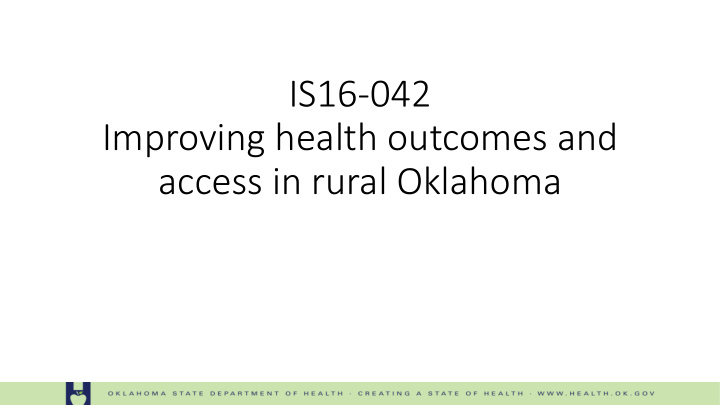



IS16-042 Improving health outcomes and access in rural Oklahoma
Tangled web we weave Insurance coverage not as straight forward as it might seem • Census considers insurance coverage as having coverage for the entire year • Lowest uninsured rates in the U.S. • Florida- 13.3% • Oklahoma- 13.9% • Georgia- 13.9% • Alaska- 14.9%* • Texas- 17.1% *Alaska’s new Governor adopted Medicaid Expansion, effective last September
Medically Underserved Areas and Populations (MUA/Ps)
Hard at work Multiple initiatives from OK Health agencies underway to attempt to address access to care • Upper Payment Limit (UPL) program (HB 2549 & SB 1149) • Sponsor’s Choice- Tribal Insure Oklahoma proposal • 1332 waiver • PMTC (SB 1179) • Governor’s Council on Workforce and Economic Development- Subcommittee on Health Workforce
Review of access to care • State should increase investment in smart infrastructure dealing with workforce issues • Teaching health centers • Reducing regulatory barriers and increasing bandwidth ability for telemedicine • Insurance coverage is only a piece of the puzzle • ACA put lots of eggs in the coverage basket; less of a priority on workforce
Health Outcomes America’s Health Rankings takes 4 groups of health determinants into ranking states based on health outcomes. 1. Behaviors include everyday activities that affect personal health. Behaviors include habits and practices we develop as individuals and families that influence our personal health and the use of health resources. Individuals can modify these behaviors with support of community, policy, and clinical interventions. 2. Community & Environment influence quality of life and life expectancy . Healthy and safe communities include those with clean water and air, affordable and secure housing, sustainable and economically vital neighborhoods, and support structures such as violence-free places to be physically active.[1] 3. Policy influences availability of resources to encourage and maintain health. Policy also influences the extent that public and health programs penetrate the general population. Policies can have a wide reach throughout a state, and they promote healthy living and judicious consumption of health care resources. 4. Clinical Care reflects the access, quality, appropriateness, and cost of care we receive at doctors’ offices, clinics, and hospitals. http://www.americashealthrankings.org/about/page/about-the-annual-report
It’s simple . . . . • Make sure your basic needs are met (food, shelter) • Eat healthier • Sit less • Move more • Possess purpose (work, volunteer, civic group) • Access health services (prevention, treatment, habilitation and rehabilitation)
AHR- Oklahoma ranks 45th http://www.americashealthrankings.org/explore/2015-annual-report/state/OK
Go after the root cause Increasing the price point of cigarettes is the single most effective strategy to reduce cigarette consumption 1 “…consensus is that every 10 percent increase in the real price of cigarettes reduces overall cigarette consumption by approximately 3 to 5 percent, reduces the number of young-adult smokers by 3.5 percent, and reduces the number of kids who smoke by 6 or 7 percent.” 2 1- The Health Consequences of Smoking—50 Years of Progress: A Report of the Surgeon General, 2014, available at http://www.surgeongeneral.gov/library/reports/50-years-of-progress/consumer-guide.pdf
2 See, e.g., Chaloupka, FJ, “Macro-Social Influences: The Effects of Prices and Tobacco Control Policies on the Demand for Tobacco Products,” Nicotine and Tobacco Research 1(Suppl 1):S105-9, 1999; other studies at http://tigger.uic.edu/~fjc/; Tauras, J, “Public Policy and Smoking Cessation Among Young adults in the United States,” Health Policy 6:321-32, 2004; Tauras, J, et al., “Effects of Price and Access Laws on Teenage Smoking Initiation: A National Longitudinal Analysis,” Bridging the Gap Research, ImpacTeen, April 24, 2001, and others at http://www.impacteen.org/researchproducts.htm. Chaloupka, FJ & Pacula, R, An Examination of Gender and Race Differences in Youth Smoking Responsiveness to Price and Tobacco Control Policies , National Bureau of Economic Research, Working Paper 6541, April 1998; Emery, S, et al., “Does Cigarette Price Influence Adolescent Experimentation?,” Journal of Health Economics 20:261-270, 2001; Evans, W & Huang, L, Cigarette Taxes and Teen Smoking: New Evidence from Panels of Repeated Cross-Sections , working paper, April 15, 1998; Harris, J & Chan, S, “The Continuum-of-Addiction: Cigarette Smoking in Relation to Price Among Americans Aged 15-29,” Health Economics Letters 2(2):3-12, February 1998, http://www.mit.edu/people/jeffrey/HarrisChanHEL98.pdf. U.S. Department of Health and Human Services (HHS), Reducing Tobacco Use: A Report of the Surgeon General , Atlanta, Georgia: HHS, CDC, National Center for Chronic Disease Prevention and Health Promotion, Office on Smoking and Health, 2000, http://profiles.nlm.nih.gov/NN/B/B/L/Q/_/nnbblq.pdf
Review of Health Outcomes discussion • Need to more effectively consider health outcomes within policy decisions outside of traditional health settings • According to America’s Health Ranking, Oklahoma is 45 th in the United States in health outcomes. • Smoking is the largest negative factor impacting those outcomes. • According to the Office of the Surgeon General of the United States, an increase in the price of cigarettes is the “single most effective strategy” to reduce smoking.
Carter Kimble Director of State and Federal Policy Oklahoma State Department of Health carterk@health.ok.gov 405.208.0380
Recommend
More recommend